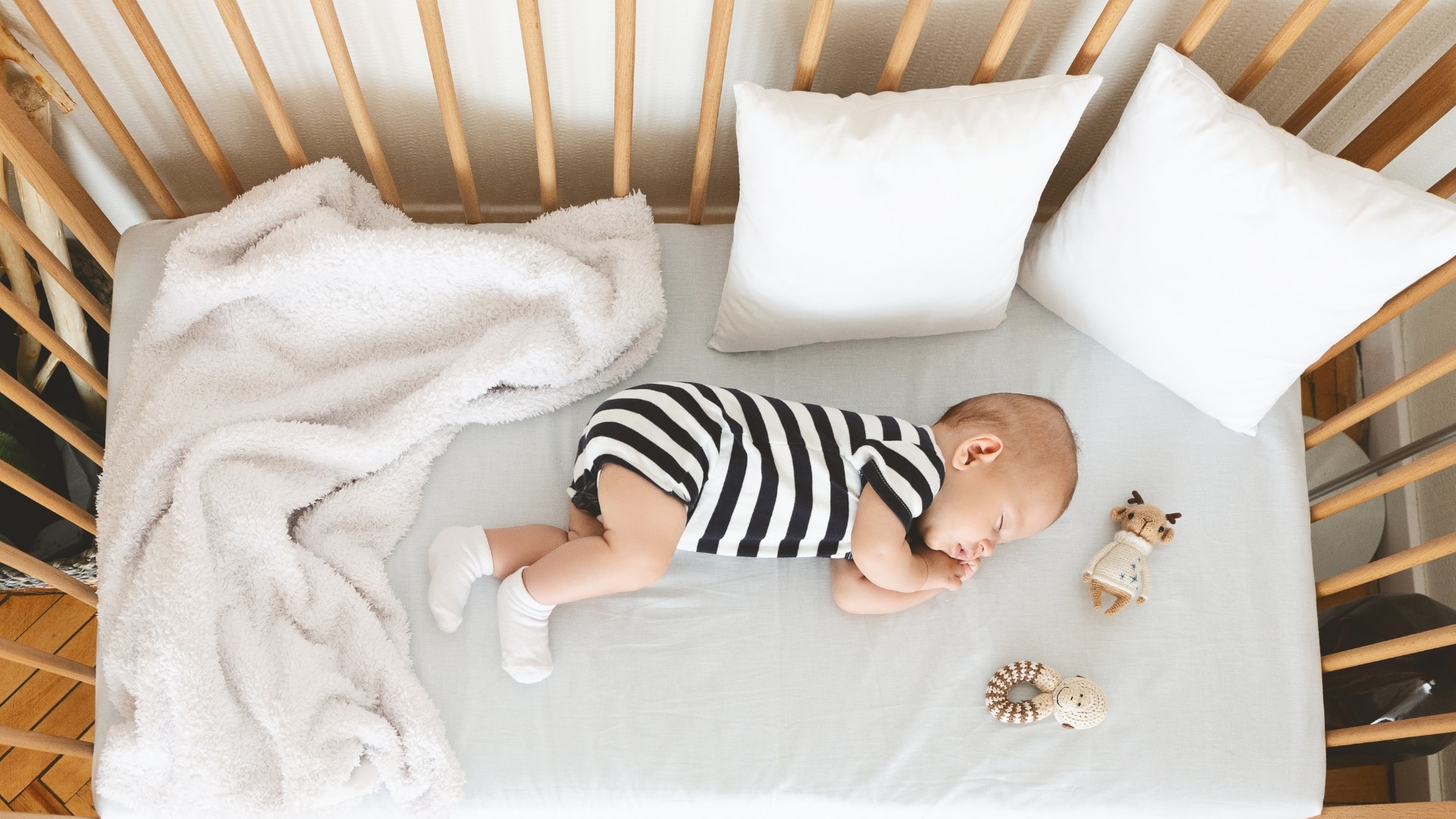Healthy baby sleep is vital for your baby’s health and well-being and knowing how much rest your little one requires in 24 hours will help you plan a suitable nap schedule for baby.
Newborns have very different sleep requirements compared to older babies and toddlers and the key to success is to adapt your baby’s nap schedule to these developmental stages.
In today’s article, I will share with you the best age-appropriate nap schedule for baby, no matter their age, ensuring healthy development and a well-rested family!
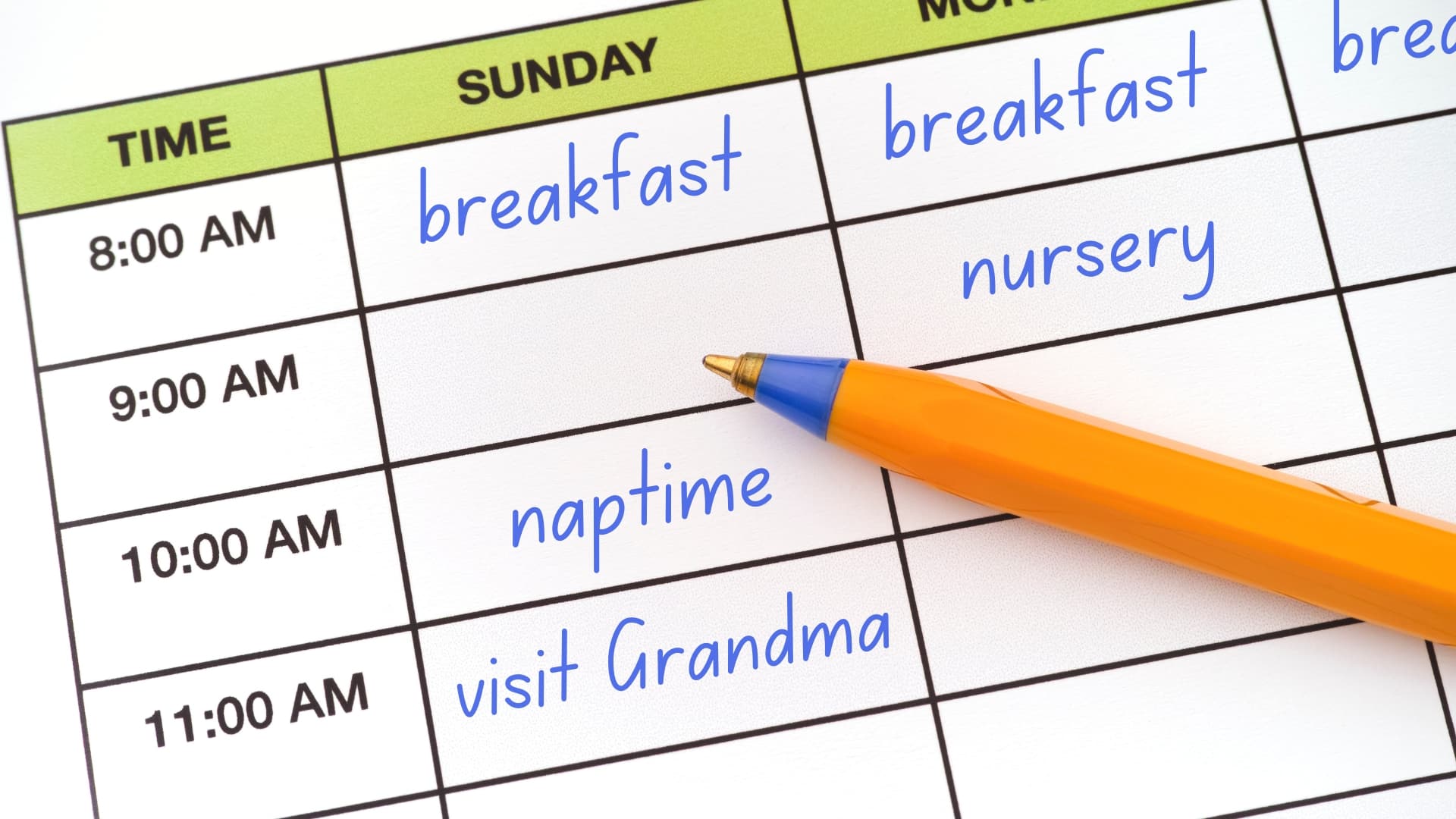
Table of Contents
How Much Sleep Do Babies Need?
Young babies generally need a lot of sleep to support their rapid growth and development this means that in the first weeks, your newborn might sleep up to 18 hours per day.
Infants (under a year old) sleep 12 to 16 hours a day and toddlers should have 11 to 14 total hours of sleep per 24 hours.
NOTE: There will be a shift from newborn sleep where they sleep and wake pretty evenly throughout 24 hours, to baby sleep where they are sleeping for longer periods at night and less during the day.
Here is a guideline for baby’s sleep requirements for 24 hours, including appropriate nap lengths:
| Age of Baby | Total Sleep Required (24 Hours) | Daytime Sleep Required (Number of Naps) |
| 0-3 months | 14-18 hours | 4-5 hours (3-5 naps) |
| 4-11 months | 12-15 hours | 3-4 hours (2-3 naps) |
| 1-2 years | 11-14 hours | 2-3 hours (1-2 naps) |
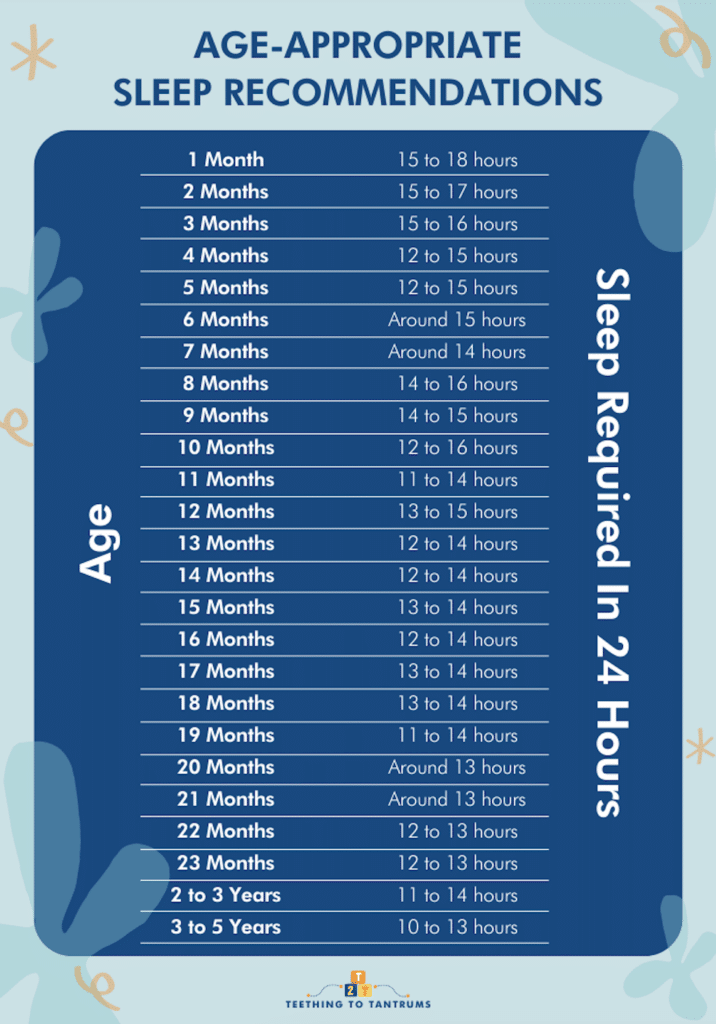
NOTE: I cannot stress enough how important daytime naps are in meeting your little one’s total sleep needs. You must look at sleep overall in 24 hours… Not separately between daytime and nighttime sleep.
How Many Naps Do Babies Need?
Your baby’s age will dictate how many naps they need.
- Newborns usually require three to five naps per day, as they sleep in short bursts around the clock. This helps them adapt to their new environment outside the womb.
- When babies reach 4 months of age, they need up to four naps a day, but by the time they are 6 months old, they will start to transition down to two naps a day. This is because during this phase a more regular nap routine starts to form, usually settling into a morning nap and an afternoon nap. Hopefully, nighttime sleep will also start to consolidate with them sleeping through the night by the time they are 6 months and not requiring night feeds.
- Between 6 to 12 months, your little one will fully transition to two naps per day. All these changes are aligned with their circadian rhythms which supports better nighttime sleep.
- By the time your little one is 18 months old, they are ready to move to one nap per day. This nap typically happens after lunch, lasting 1 to 3 hours.
Maintaining a consistent nap routine helps ensure your baby gets the restorative daytime rest they need so that they can get through to bedtime without becoming fractious and overtired.
Overtiredness is always your enemy as a parent and should be avoided at all costs.
Keep in mind that these are all guidelines and that every child is different and may have unique sleep needs.
The best way to assess what your baby needs is to observe your baby’s sleep cues and act accordingly.
A good indicator that you need to look at daytime sleep schedules is if you notice your baby is restless at night or resisting bedtime. This might be due to the fact they are getting too much daytime sleep and are not ready for sleep… or that they are not getting enough daytime sleep and are overtired…
Whatever the case you will need to adjust your little one’s daytime nap schedule.
Looking to get your little one to sleep quickly and effortlessly? Check out my Bedtime and Nap Cheat Sheet and master the art of making daytime naps and bedtimes as seamless as possible.
A bedtime & nap cheat sheet so good your little one will ask you to put them to bed...
Laura Williams "This is a life saver! I'm so glad I downloaded your bedtime & nap cheat sheet. My little one actually asked me to put him to bed last night! Unbelievable! Thank you so much!"
Click Here For The FREE Cheat Sheet
0-3 Month Sleep Schedule Guidelines
In the first three months of life, your baby’s sleep is gradually organized into a more predictable pattern. This is a period of adjustment to being out of the womb and establishing future approaches to sleep.
At this age, sleep is distributed throughout the day and night with often (especially in the early weeks) no clear distinction between the two.
For many parents, this is the most exhausting period. You are getting used to having a new little person in your life and you are very tired. In this mix of joy and desperation, you will need to help your baby establish a more structured sleep schedule.
For 0 to 3-month-olds here are some key things to know and consider when assessing their sleep needs:
- Ideal Amount Of Daytime Sleep: This will range from 4 to 5 hours across several naps.
- Average Number Of Naps: Typically 4 to 5 naps per day.
- Number And Length Of Wake Windows: Wake windows last about 45 to 90 minutes.
- Ideal Bedtime: Generally, bedtime might fall between 7:00 p.m. and 8:00 p.m.
Sample 1-Month-Old Sleep Schedule
To be honest, at one month, your newborn is unlikely to have a set sleep schedule. This is because newborns typically sleep in short bursts throughout a 24-hour day.
They can sleep a total of 16 to 18 hours, but likely won’t sleep through the night. While they are growing so rapidly you must continue to feed them through the night.
Feeding schedules will be the driving force behind your baby’s sleep at this stage, with feedings every 2 to 3 hours being common.
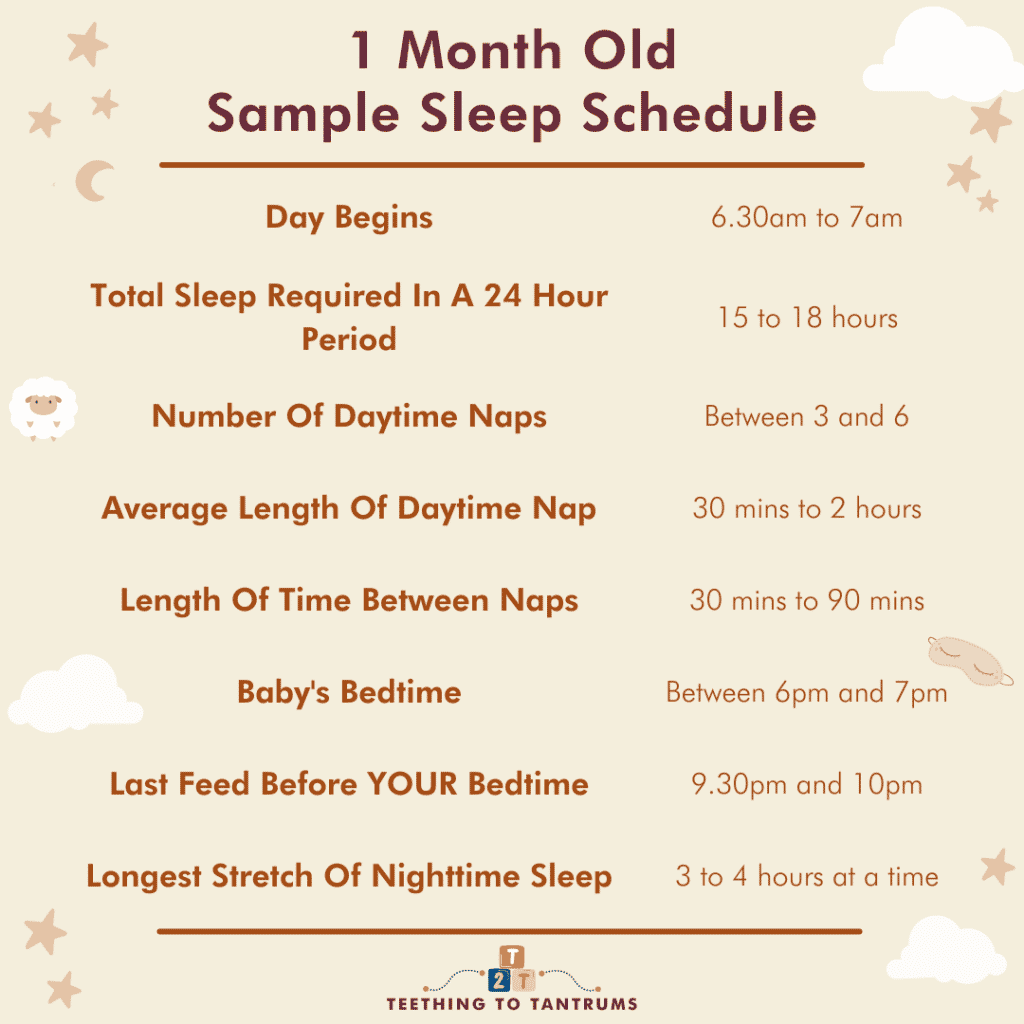
Sample 2-Month-Old Sleep Schedule
Your 2-month-old sleep schedule will still involve your baby napping frequently during the day with naps lasting anything from 30 minutes to a couple of hours and wake periods will range from 60-90 minutes.
If you are lucky, nighttime sleeping stretches may begin to lengthen a little.
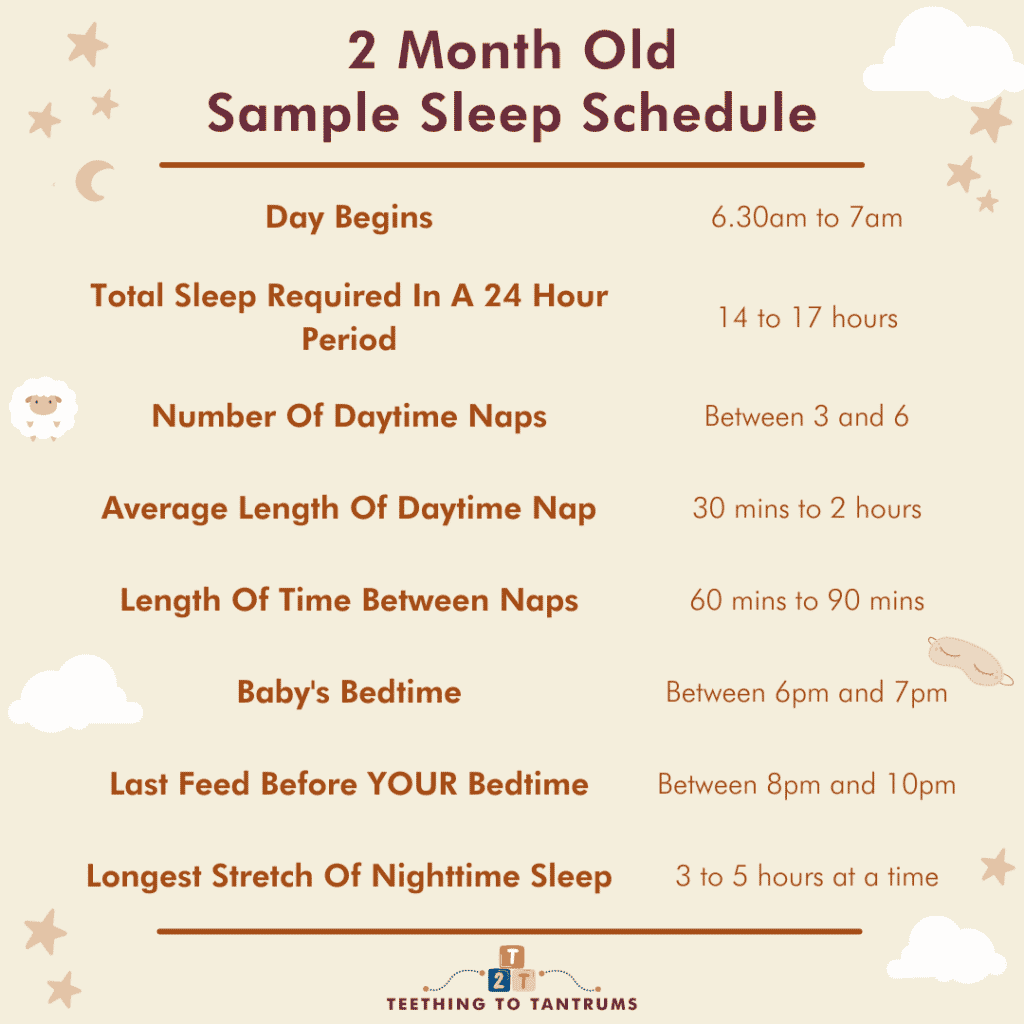
Sample 3-Month-Old Sleep Schedule
By three months, you might start to notice a more structured pattern in sleep with longer stretches at night and more predictable nap times.
Babies of this age often nap 3 to 4 times a day now lasting 60-90 minutes, and it’s common to have a more established bedtime routine.
Some babies might begin to sleep through the night for about 6 hours.
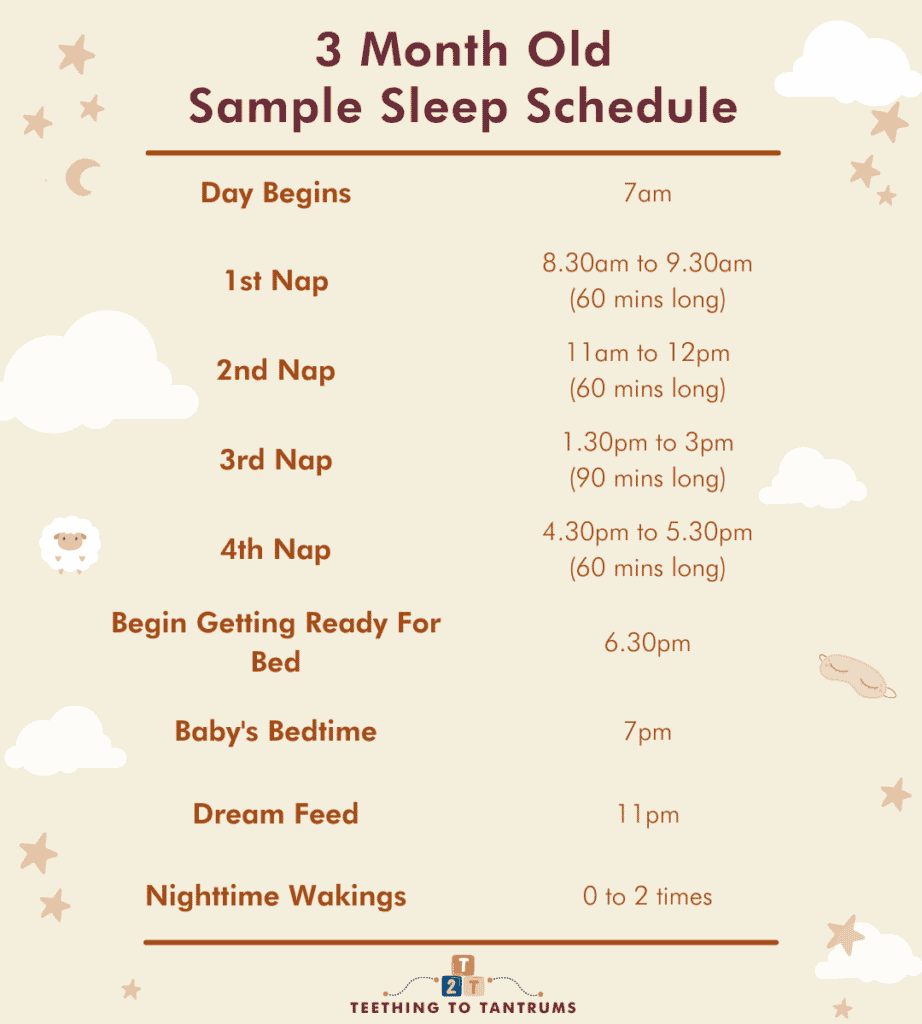
4-6 Month Sleep Schedule Guidelines
4 to 6 months is a time in your baby’s development when some big and significant changes can happen on the sleep front. With the potential of baby sleeping through the night!
Your baby’s sleep schedule will become more predictable with gradually longer night stretches resulting in little to no waking and marking the end to night time feeding by 6 months of age for some.
It is important during this period to start to cultivate a consistent daily routine to support your baby’s developing circadian rhythm.
Sample 4-Month-Old Sleep Schedule
At 4 months, your baby should be settling into a more structured sleep pattern.
Swaddling may still be comforting, although some babies may start to outgrow it and be ready to transition out of full swaddling. It is important that once your baby starts to roll over you no longer swaddle them.
Gentle sleep training can also begin around this age if you choose to do so consisting of putting your baby down for naps while drowsy and not fast asleep and encouraging independent play in their cribs while awake.
Here is a general outline for a 4-month sleep schedule:
- Amount of sleep needed in 24 hours: 12 to 17 hours total
- Ideal Amount Of Daytime Sleep: Average Number Of Naps: 3 to 4 naps lasting anywhere from 30-90 minutes long. If your baby is only taking 3 naps per day they will probably last longer i.e. up to 1.5 hours long.
- Number And Length Of Wake Windows: 1.5 to 2 hours of wakefulness between naps
- Ideal Bedtime: Between 6:00 PM to 7:30 PM
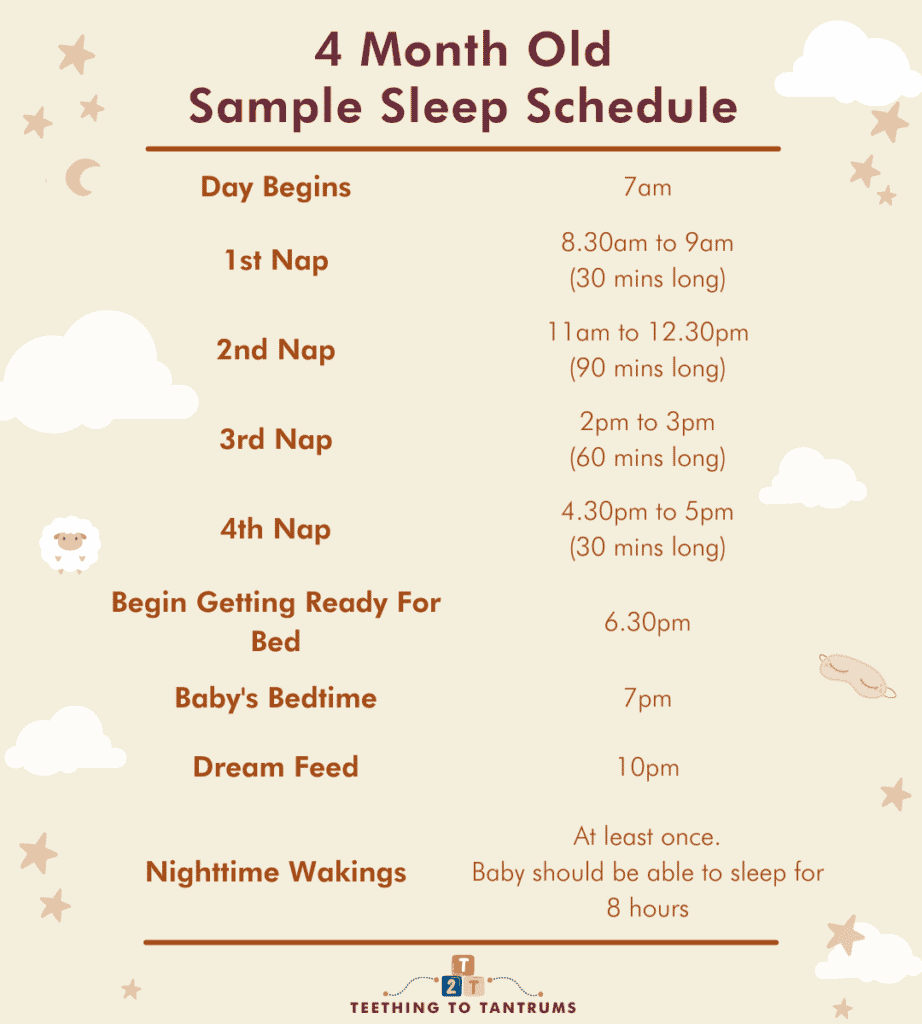
Your baby can now have a recognizable bedtime routine starting with a bath, followed by a bedtime book, and ending with a lullaby.
Your baby will now start to be more aware of their surroundings and enjoy focusing on your face and voice and interacting with you. Make sure they have plenty of time to explore their new world.
TOP TIP: 4 months is a very common age for sleep regressions to occur. This can have a significant impact on baby’s sleep and nap schedule.
Sample 5-Month-Old Sleep Schedule
By 5 months, your baby may show signs of being able to stay happily awake for longer periods of wakefulness and consolidate their sleep more at night. Naps start to become shorter and at more regular times as well.
- Amount of sleep needed in 24 hours: 14-15 hours
- Ideal Amount Of Daytime Sleep: 2-3 hours total
- Average Number Of Naps: 3 naps
- Number And Length Of Wake Windows: 2 to 2.5 hours of wakefulness
- Ideal Bedtime: Consistently around 6:30 PM to 7:30 PM
Continue to provide stimulated play during wake periods but keep a close eye on sleep cues to avoid overtiredness which can easily occur as they become absorbed in taking in their new world.
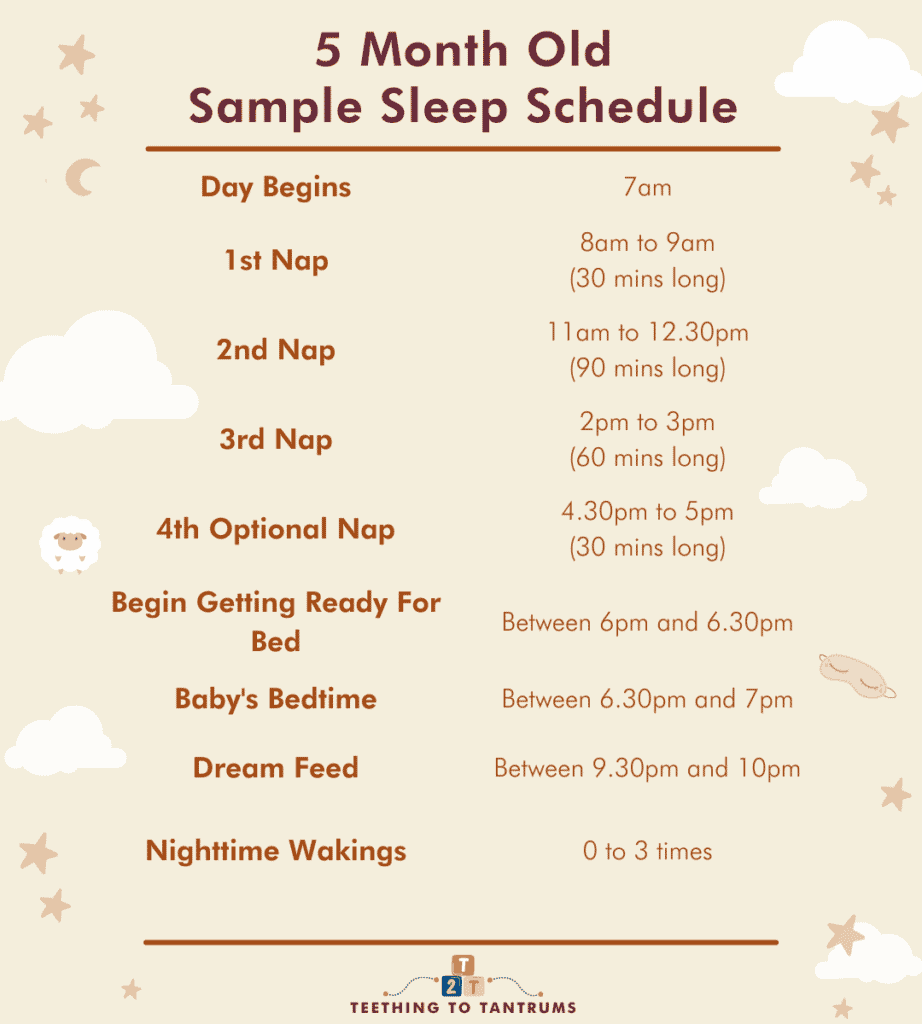
TOP TIP: Watch for any signs of teething, as they can disrupt sleep and may require extra soothing.
Sample 6-Month-Old Sleep Schedule
6 months is a big developmental milestone where babies often learn to sit and start eating solids which means they are able to go all night without feeding.
As their fine motor skills develop your baby is able to explore their world more too. All this change also coincides with them having a more defined sleep and nap schedule.
If your baby has not learned to do so already, they are now capable of learning to self-soothe and may be sleeping through the night more consistently, or on the verge of doing so.
- Amount of sleep needed in 24 hours: 12 to 14 hours total
- Ideal Amount Of Daytime Sleep: 1Average Number Of Naps: 2 to 3 naps
- Number And Length Of Wake Windows: 2 to 3 hours of wakefulness
- Ideal Bedtime: Between 6:00 PM to 8:00 PM
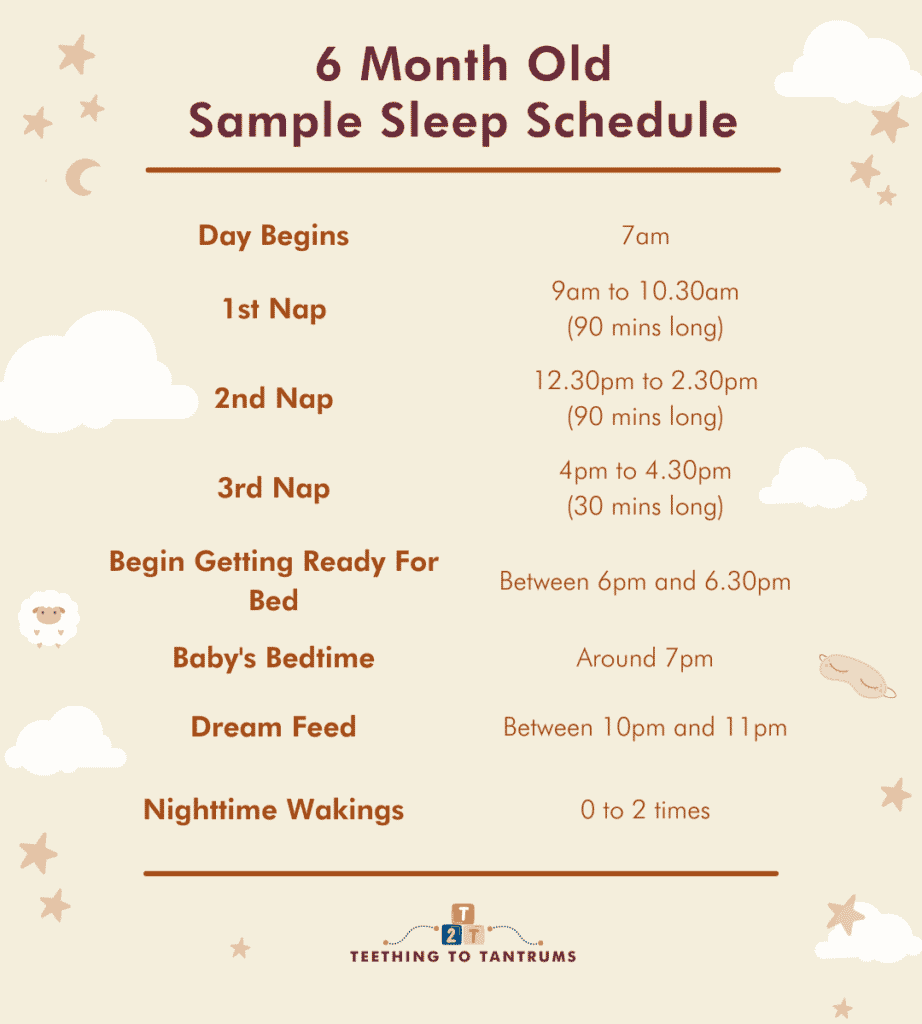
NOTE: A bedtime routine is influential in helping your baby wind down and be ready for sleep. Sleep training methods are often more successful at this age, as babies can adapt to structured sleep times.
7-8 Month Sleep Schedule Guidelines
Between 7 and 8 months, the nap schedule for baby becomes even more important for your baby’s growth and development.
Learn what the best nap schedule for baby is below:
Sample 7-Month-Old Sleep Schedule
By the time your baby is 7 months old, they usually require about 14 hours of sleep daily, which includes nighttime rest and multiple naps. Babies at this age should be having two to three 1-hour naps a day, aiming for around 2–3 hours of daytime sleep overall.
- Amount of sleep needed in 24 hours: 14 hours
- Ideal Amount Of Daytime Sleep: 2-3 hours
- Average Number Of Naps: 2-3
- Number And Length Of Wake Windows: 2.5-3.5 hours apart
- Ideal Bedtime: Between 7:00 PM and 7.30.PM
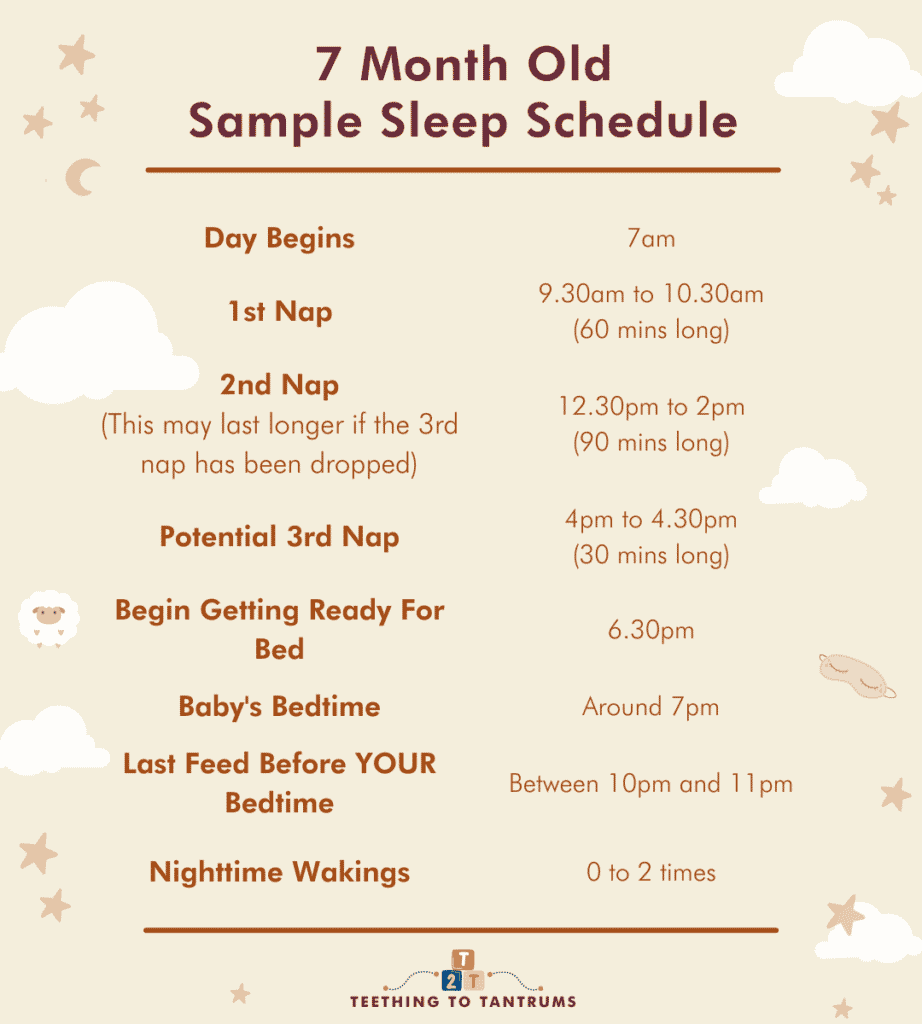
At 7 months, you should remember to incorporate suitable activities during wake windows to promote your baby’s rapidly growing physical development. This will also help them to be more ready for sleep when it comes around too.
Sample 8-Month-Old Sleep Schedule
At 8 months, babies will generally follow a similar pattern to the 7-month schedule, with some little ones staying awake for slightly longer periods between naps.
I would advise aiming to maintain the daily routine that you’ve built and simply adjust naps as needed to accommodate your baby’s shifting sleep needs.
- Amount of sleep needed in a 24 hour period: 14-16 hours
- Ideal Amount Of Daytime Sleep: Approximately 2-3 hours, leaning towards the lower end as they approach 9 months.
- Average Number Of Naps: Typically still 2-3, with the possibility of transitioning to 2.
- Number And Length Of Wake Windows: Between 2.5-3.5 hours
- Ideal Bedtime: Consistency remains key, so continue with a bedtime between 7:00 PM and 7.30 PM.
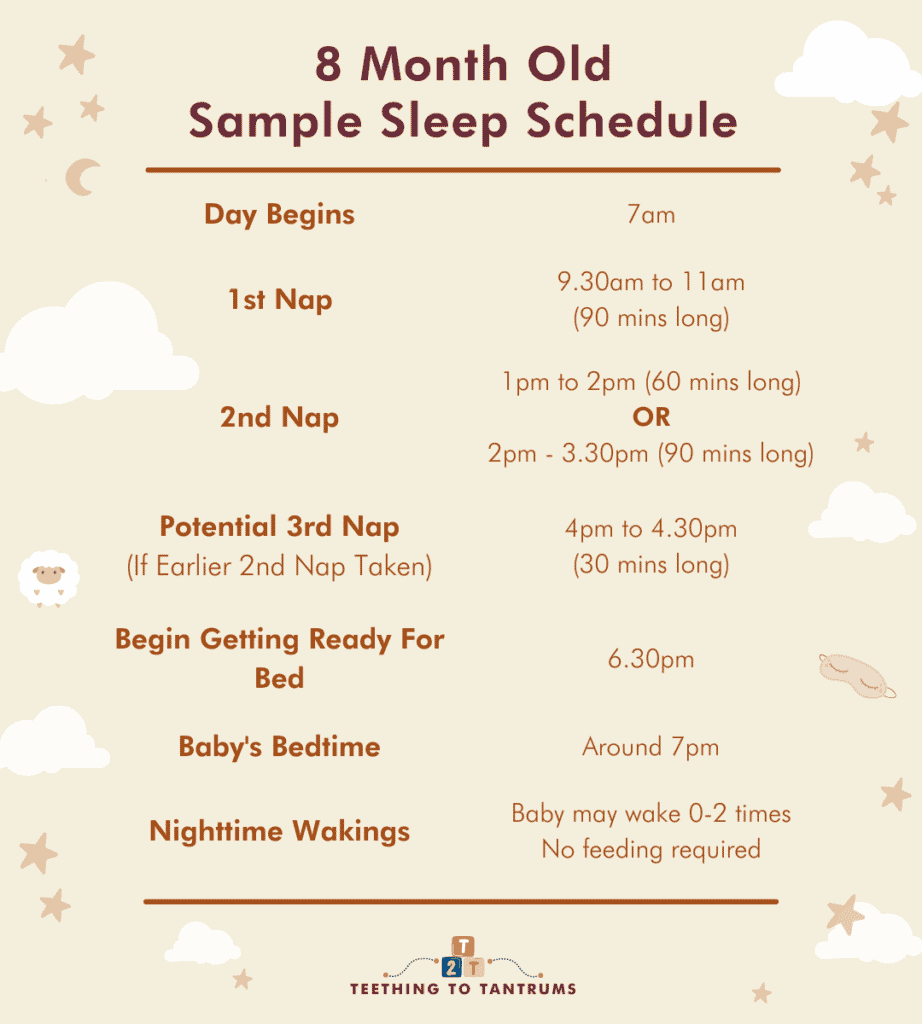
TOP TIP: If your baby had a quick nap and is showing signs of being tired during their wake window (having only been awake for a short time…) then let them go to sleep again and DO NOT wait for ‘nap time’. Trying to keep your baby awake will only lead to them getting overtired and being unable to settle.
9-12 Month Sleep Schedule Guidelines
Between 9 and 12 months is when naps become more predictable allowing you to plan your day with greater certainty.
Healthy sleep patterns are now more than ever crucial for development and will help prevent overtiredness, which can lead to fussiness and sleep resistance.
- Amount of sleep needed in 24 hours: 10-16 hours
- Ideal Amount Of Daytime Sleep: 2-3 hours
- Average Number Of Naps: 2
- Number And Length Of Wake Windows: 3-4 hours
- Ideal Bedtime: 7.00 p.m.
Throughout this phase, it is important to continue to encourage your little one to learn to self-settle for naps and bedtime by avoiding rocking or feeding to sleep and encouraging independent play.
Sample 9-Month-Old Sleep Schedule
At 9 months, your baby typically needs about 14-15 hours of sleep over a 24-hour period. This includes roughly 11-12 hours of nighttime sleep plus 2-3 hours spread over two daytime naps.
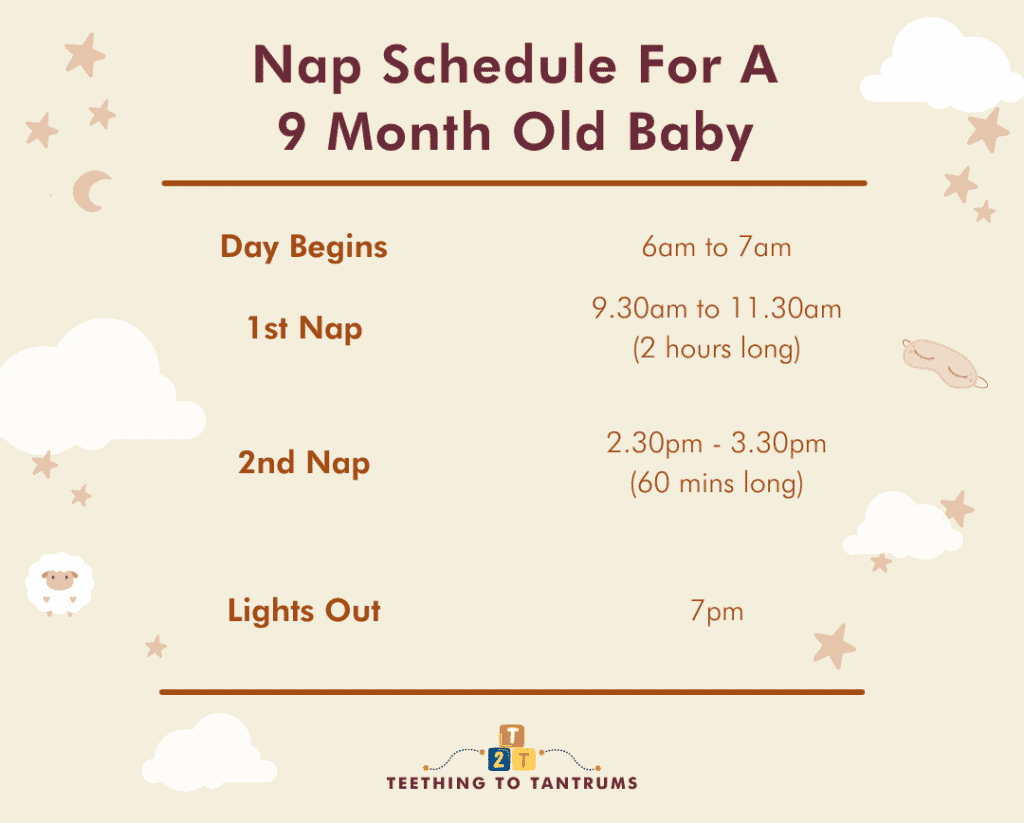
TOP TIP: Make naps a priority. As part of establishing a healthy 9-month-old sleep schedule, try and make sure that your baby takes most of their naps at home. The occasional nap on the go is inevitable and OK, but do this daily.
Sample 10-Month-Old Sleep Schedule
At 10 months, your baby typically needs 12-16 hours of sleep in a 24 hour period. They will have two naps a day, lasting about 1-2 hours each.
This age is when your baby may start to crawl, pull to stand, and cruise around furniture so keep a close eye on sleep cues as all this new activity can easily lead to overtiredness.
Maintaining a consistent bedtime is hugely important and will impact positively your 10-month-old’s overall sleep.
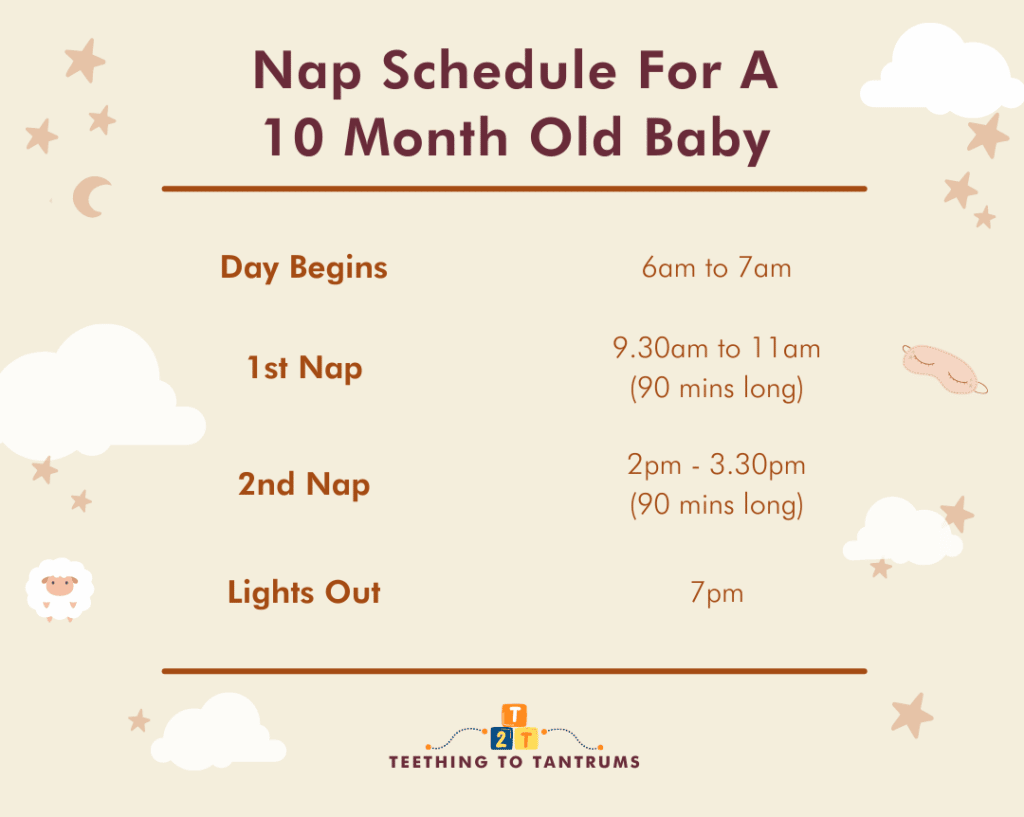
TOP TIP: To keep nap times on track aim to put baby down for their morning nap around 3 hours after waking up and their second nap about 3 hours after the first has finished.
Sample 11-Month-Old Sleep Schedule
By 11 months, your little one’s nap and sleep schedule is similar to a 10-month-old’s. Your baby will need on average 12-14 hours of sleep in a 24 hour period with 2-3 hours of that taken in naps.
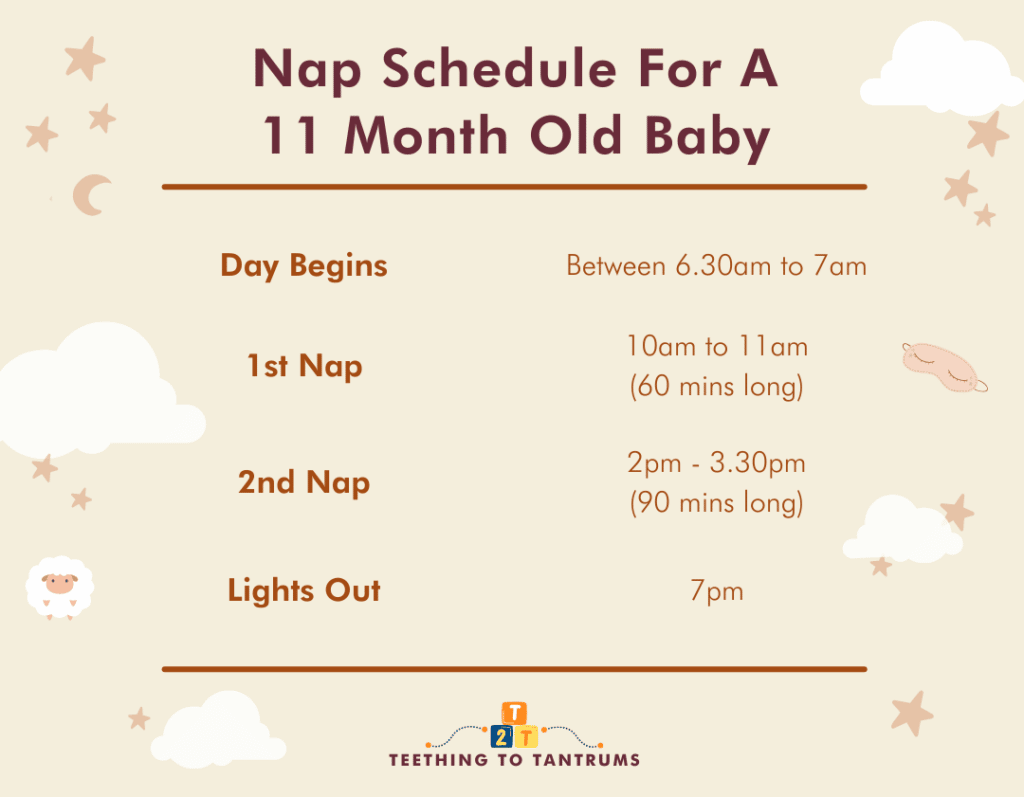
Sample 12-Month-Old Sleep Schedule
Around 12 months, your baby will need approximately 13-15 hours sleep in a 24 hour period with up to 11-12 hours being taken at night and the balance taken in either 1 or 2 naps.
Ensure your baby is still getting adequate nighttime sleep, and consider introducing sleep training methods if baby is struggling to sleep independently.
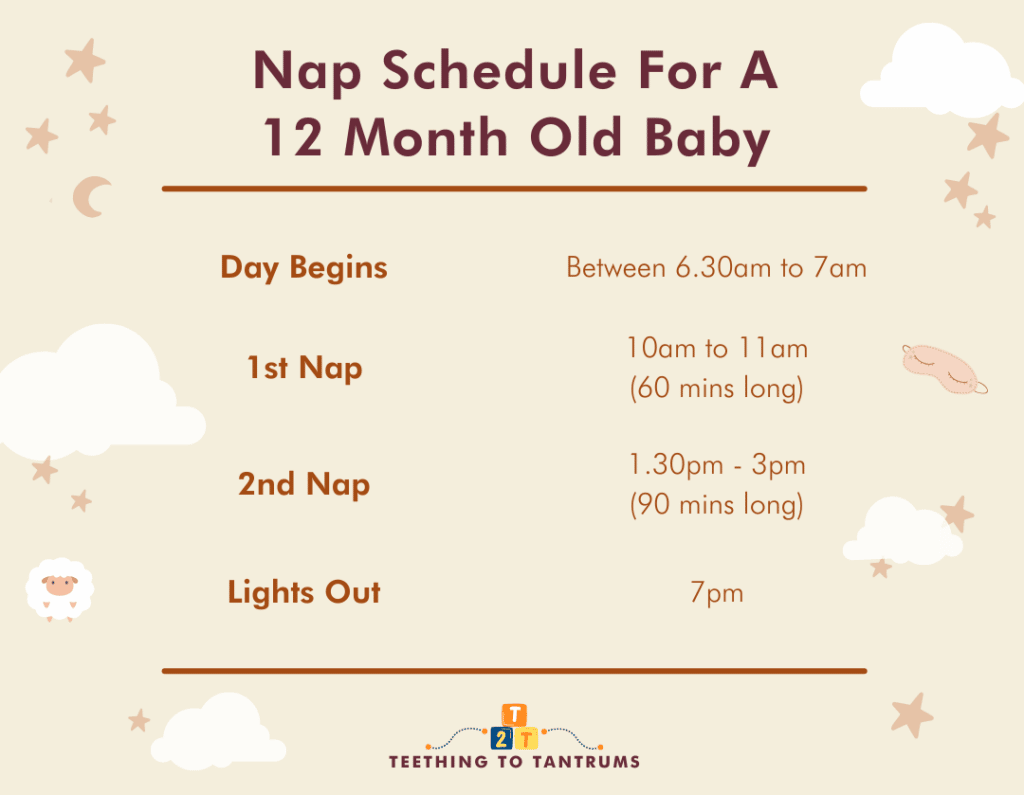
TOP TIP: 12 months is usually too early for one nap consistently. While some 1-year-olds can get by with only one nap on a calm day… most will not transition to a one-nap schedule until they are 14 to 16 months of age.
18-Month Sleep Schedule Guidelines
By 18 months, your toddler has more than likely transitioned to one longer nap a day and should be more than capable of self-soothing. Continue to maintain your nap schedule to keep your little one’s sleep on track.
- Amount of sleep needed in 24 hour period: 11-14 hours
- Ideal Amount Of Daytime Sleep: 2-3 hours
- Average Number Of Naps: 1 nap per day
- Length Of Wake Windows: 5-6 hours between sleep periods
- Ideal Bedtime: Typically between 7:00 PM and 7.30 PM
Sample 18-Month-Old Sleep Schedule
Getting your toddler on a sleep schedule helps stabilize their internal clock and ensures they get enough rest. Here’s what that might look like:
Morning wake-up: 6:30 – 7 AM
Nap: 12:30 PM to 2:30 PM
Bedtime: 7:00 PM
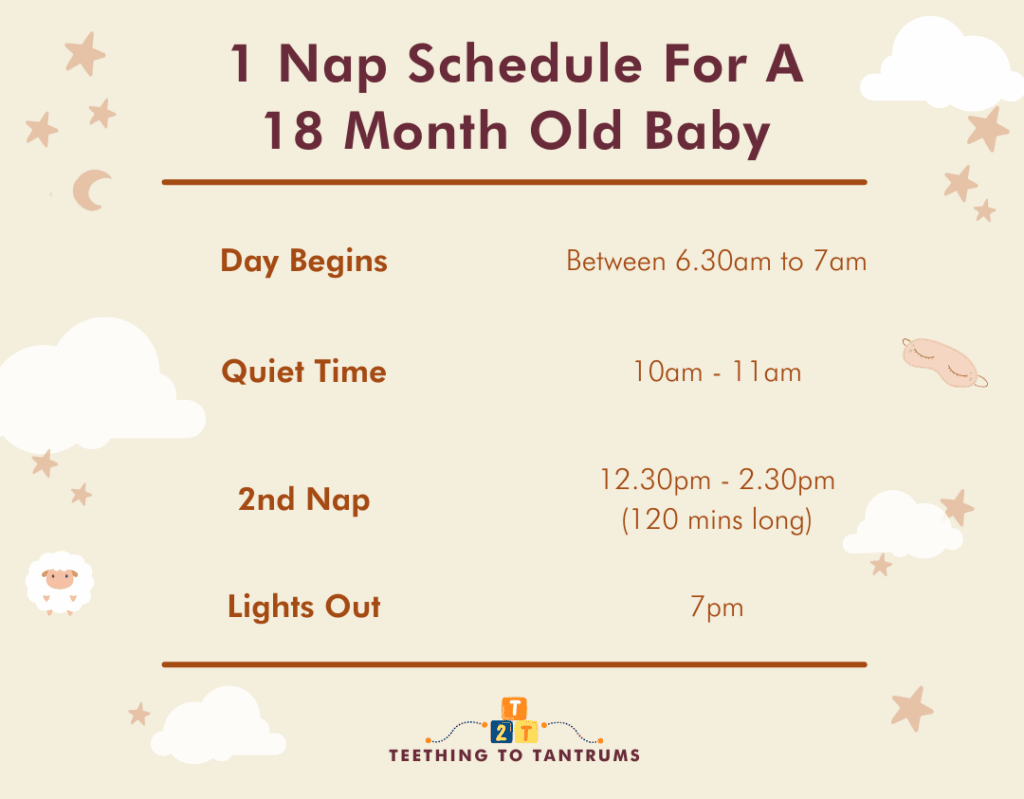
This is just a guideline but, as I always say, keep an eye on sleep cues, and don’t be afraid to make sleep adjustments based on your toddler’s cues and developmental milestones.
Baby Naptime Tips
Throughout all my years of experience, I have found many tips and tricks that have been very helpful in managing baby nap times. One of which I will never stop teaching parents…
My Biggest Tip For Baby Naptime
The first rule to establishing a nap schedule for baby is to recognize the signs of sleepiness in your baby and act on them quickly. Common baby sleep cues are staring off into space, yawning, squirming, rubbing their eyes, pulling at their ears, or becoming fussy.
If your baby starts to cry, has jerky movements, or arches their back chances are you have missed the initial cues and they need to sleep urgently.
Other Baby Naptime Tips
- Understand your baby’s sleep cycles. Babies have different sleep needs based on age, affecting their nap schedule. Newborns will nap frequently throughout the day, while older babies tend to consolidate sleep into longer stretches. Learn your baby’s natural circadian rhythms to better plan nap times that align with their sleepiness cues.
- Create a comforting sleep environment. Creating the right sleep environment as your baby grows will reinforce sleep habits. While newborns will sleep practically anywhere as your baby grows and becomes more aware of their surroundings they will nap better in a designated sleep space. Use blackout curtains and a white noise machine to create an ideal napping atmosphere. Try to have your baby nap in the same place each day to associate that space with sleep, which can lead to quicker and more effective napping and help with self-soothing.
- Develop a pre-nap routine. A soothing pre-nap routine can indicate it’s time to wind down. This routine might include reading a quiet story, dimming the lights, or a gentle cuddle and a lullaby. Remember that repetition of these actions will signal to your baby that naptime is near, helping baby transition to sleep more easily.
- Balance nap duration. Aim for balance in nap length; both short and long naps serve a purpose. Typically, morning naps are shorter while afternoon naps will be longer to get them through to bedtime without getting overtired. As your baby grows in the first year there is quite a bit of nap transitioning so keep an eye on your baby’s age-appropriate sleep total and adjust your baby’s nap times to ensure they get adequate daytime rest without compromising nighttime sleep.
- Offer quiet times as a substitute for nap times. While most babies will continue to need naps, some babies may start to resist napping, and nap resistance may occur at any time. If this is the case, I would always advise leaving your little one to play quietly in their crib instead of a nap. Chances are they will fall asleep eventually but getting into the habit of resting, especially after lunch will lay the foundation for the future years when quiet time should become the norm.
- Teach your little one to self-settle. Teaching our baby to self-settle at nap times can help with bedtime self-settling so try to put your baby down for their naps drowsy but not asleep. Read this post to learn more: How to Self-Soothe Baby: The Ultimate Guide To Peace & Calm
- Get outside every day. Exposure to fresh air and natural light has been proven to help with childhood sleep as it balances circadian rhythms and melatonin production. So try to get outside each day.
- Encourage your baby to be active and engaged when they are awake. During wake periods ensuring that your baby is engaged will help them be more ready for nap times. It is also important that they get plenty of opportunities to practice any new skills they might be learning.
- Don’t be afraid to wake your older baby from a nap. This is very important. To keep your nap schedule and in fact, your whole sleep schedule on track… remember that it is OK to wake your older baby from a daytime nap. Allowing your baby to sleep too much during the day can impact nighttime sleep!
- Don’t keep your baby awake to fit the nap schedule. Equally, if your baby is showing signs of being tired at a time that they would not normally nap, it is important to react and let them sleep even if it is just a cat nap.
- Second to my point above, utilize the cat nap! Cat naps can happen at any age and are when your baby falls asleep in the stroller or car for short periods. It is important to not let these cat naps disrupt your nap routine so be prepared to wake your baby from a cat nap once you are home or adjust other nap time to accommodate the sleep. By the same token, you can use cat naps to help your sleep routine. For instance, letting your baby have a short 30-minute nap in the late afternoon can help them get through to bedtime without becoming overtired. Remember, late afternoon cat naps should as a rule not last longer than 30 minutes.
- Consider gentle sleep training techniques. If your baby struggles with naps, sleep training methods can be beneficial. Choose a technique that you are comfortable with, and be patient and consistent with its application.
Frequently Asked Questions About Creating A Nap Schedule For Baby
This section addresses common inquiries regarding your baby’s nap schedule and the importance of napping.
Q: When do babies drop naps?
A: Your baby will gradually reduce the number of daily naps as they grow. Most babies drop from 4-3 naps at around 5-6 months, then from 3-2 naps at around 8-9 months, and finally to one nap around 12 to 18 months of age. However, the exact time can vary based on individual development and needs.
Read these nap transition posts to learn more:
- Survive Nap Transitions With These 15 Expert Tricks.
- 4 To 3 Nap Transition: Don’t Let It Ruin Your Progress
- How To Handle The 3 To 2 Nap Transition Like A Professional
- 2 To 1 Nap Transition: How To Make The Switch Successfully
Q: Why do babies need to nap?
A: Naps are crucial for your baby’s growth and health. They help with memory consolidation, learning, and emotional regulation. Napping also gives their body time to rest and recover, supporting physical growth.
Q: Should you keep a baby on a nap schedule?
A: Yes, maintaining a consistent nap schedule helps regulate your baby’s sleep patterns. It makes it easier for them to fall asleep and wake up at expected times. Very importantly a well-established nap routine will benefit nighttime sleep as well.
Q: Why do babies refuse to nap?
A: Babies may refuse to nap for several reasons, such as being overstimulated, not feeling well, or experiencing growth spurts. Changes in routine or the environment can also disrupt their willingness to nap.
Q: Is it bad if my baby misses a nap?
A: Missing a nap occasionally is not harmful, but regular missed naps can lead to overtiredness and make it harder for your baby to sleep well at night. Aim to keep naps as consistent as possible.
Q: When should I establish a nap routine for my baby?
A: You should start a nap routine as soon as possible, as it can set the foundation for healthy sleep habits. A routine can be established as early as a few months old, adjusting as your baby grows and changes. But it’s never too late to start!
Q: What is the ideal nap length for a baby?
A: The ideal nap length varies by age, ranging from 30 minutes to two hours. Pay attention to your baby’s sleep cues to determine the best nap duration, as each baby’s sleep needs are unique.
Need More Parenting Help?
- Download our FREE Perfect Sleep Cheat Sheet. It’s a free, easy-to-use and proven formula designed for parents of 0-5 year olds to master the art of consistently undisturbed and restful sleep without the yelling, nagging or exhausting long-winded evenings.
- Check out our Parenting Toolbox. You’ll get access to expertly-chosen products that you can guarantee are the best for your little one and your wallet.
- Ready to create the calm, peaceful evenings you deserve? Then checkout our most popular course - The Bedtime Battles Masterclass

A bedtime & nap cheat sheet so good your little one will ask you to put them to bed...
Laura Williams "This is a life saver! I'm so glad I downloaded your bedtime & nap cheat sheet. My little one actually asked me to put him to bed last night! Unbelievable! Thank you so much!"
Click Here For The FREE Cheat Sheet

